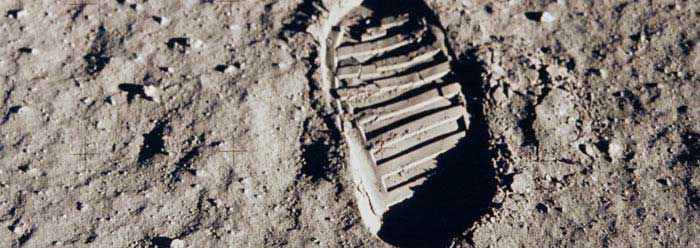A small minority of people still speculate that the Apollo 11 mission was a hoax. But the truth of the matter is that the world changed forever on July 20, 1969.
Exactly 40 years ago, millions of people around the world had their eyes glued to television sets to witness the momentous event. Four days after the Saturn V rocket launched from Kennedy Space Center, US astronaut Michael Collins orbited the moon in the Columbia command module while his colleagues below, Neil Armstrong and Edwin "Buzz" Aldrin, stepped off the Eagle lunar module and into history.
The Space Age had begun with the successful launch of the Soviet Union's Sputnik 1, the first Earth-orbiting artificial satellite, which celebrated its 50th anniversary in 2007. The US and the Soviet Union became locked in a race to be the first to put a man on the moon.
"I believe that this nation should commit itself to achieving the goal, before this decade is out, of landing a man on the Moon and returning him safely to the Earth. No single space project in this period will be more impressive to mankind, or more important for the long-range exploration of space; and none will be so difficult or expensive to accomplish,"1 President John F. Kennedy, Jr. told Congress in 1961.
Kennedy didn't live to see this hope manifest. But after eight more years of space missions, the world celebrated the successful landing of Apollo 11. The event marked a new era in scientific exploration and investigations.
Space exploration has also given us more insight into the complexity and rich design of our universe. It also showed the ingenuity of human endeavor, and the amazing accomplishments that can arise from the unlikeliest places.
BBC News reported about the "unsung heroes who designed and built the Apollo Guidance Computer (AGC), including an army of "little old ladies."
Don Eyles was a 23-year-old graduate of Boston University when he was tasked with making the software for the AGC that would eventually land Armstrong and Aldrin on the moon. "I don't recall the risk and the responsibility and the fact that other people's lives were to some extent in our hands,"2 he told the BBC.
The software was later "woven" together by ex-textile workers and watchmakers—mostly women—who strung together the copper wire that made up the computer "circuitry." In comparison, the microchips in today's average cell phone has exponentially more processing power than the computers aboard Apollo 11.
Since that first moonwalk, six more successful landings have been conducted. More man-made satellites are reaching further out to explore our solar system. And just recently, after about a month of delays, NASA successfully launced the space shuttle Endeavour, which docked at the International Space Station last week.
With each new discovery, King David's songs become more alive: "When I consider thy heavens, the work of thy fingers, the moon and the stars, which thou hast ordained…The heavens declare the glory of God; and the firmament sheweth his handywork.... By the word of the LORD were the heavens made; and all the host of them by the breath of his mouth."3
References
- Kennedy, J. F. 1961. Special Message to the Congress on Urgent National Needs. John F. Kennedy Presidential Library & Museum. Posted on jfklibrary.org, accessed July 16, 2009.
- Fildes, J. Weaving the way to the Moon. BBC News. Posted on news.bbc.co.uk July 15, 2009, accessed July 16, 2009.
- Psalm 8:3; 19:1; 33:6.
- Also see Apollo 11 Partial Restoration HD Videos, released by NASA July 16, 2009.
Image Credit: NASA
* Ms. Dao is Assistant Editor at the Institute for Creation Research.
Article posted on July 20, 2009.

















